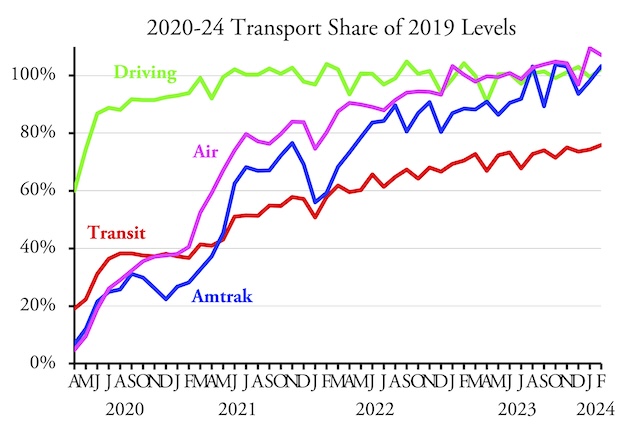After accounting for Leap Day, Americans drove almost 2.3 percent more miles per day in February 2024 than in the same month of 2019, according to data released by the Federal Highway Administration on Friday. Rural driving was 9.7 percent more than before the pandemic while urban driving was 0.8 percent less. At least some of these differences are due to people moving from urban to rural areas.
 The February 2024 line for driving is obscured by the line for Amtrak, but both are approximately 102 percent.
The February 2024 line for driving is obscured by the line for Amtrak, but both are approximately 102 percent.
While Amtrak, air travel, and driving have all fully recovered from the pandemic, transit has not. When I posted February 2024 transit data last week, someone commented that “Some areas have nearly recovered” while “areas like the Bay Area drag the data down.” It’s true that a handful of areas have recovered, in many cases because they are giving away transit rides for free. But most have not, unless you define 80 percent as “nearly recovered.” As of last week’s February data, out of the nation’s 50 largest urban areas, only 2 have fully recovered and only three more saw 90 percent of pre-pandemic ridership.
In addition to the Bay Area, ridership in Atlanta (52.5% of 2019), Chicago (64.5%), Boston (65.3%), Denver (66.0%), Minneapolis-St. Paul (63.0%), Philadelphia (67.5%), Phoenix (53.6%), Pittsburgh (56.5%), and St. Louis (61.7%) all remain both well short of recovery and well below the national average of 75.8%. Of these, Chicago, Boston, and Philadelphia have historically been among the nation’s six major transit regions and the others have all invested billions in rail transit. In any case, it’s not just the San Francisco Bay Area (64.0%) dragging the data down.
For a long time, Washington DC transit was well below the national average. But the Biden Administration has been pressuring federal employees to return to offices at least a few days a week. As of February, DC transit was at 82.5 percent. We’ll soon know if they get it any higher.
As Antiplanner readers know, transit ridership was already declining before the pandemic. The pandemic may have just accelerated trends that were already taking place.








Happy TAX DAY. And Remember on this day when We fork over several Trillion dollars in our wealth to pay for wars in Izrael and Ukraine, and NATO because Europe wont pay for anything.
Somewhere in Zelensky’s rectum is the USB drive with all Hunter Bidens and his Dad’s business dealings along possible pictures him doing underage prostitutes on Willy Wonka sized Pile of cocaine.
That’s why the Russians Always miraculously miss every bombing/missile strike despite Hypersonic GPS guided missiles.
How long does America have to wait before its elected leaders realize that, by and large, Americans don’t want buses and trains, they want better highways? At what point will politicians finally say, “Okay, that’s enough. Let’s shift our attention to that which matters.”
Where is your source regarding transportation demand?
Our population has grown since 2019 and neither mode of transport has caught up at the same rate of population growth.
If you remove the metro areas and cities with population loss lie San Francisco, transit on the chart would be over 80%.
“February Driving Up 2.3 Percent from 2019″
Seems like a bad thing overall since driving is more deadly (per mile or per capita, take your pick) than transit. Not to mention the secondary health effects of driving:
”
Air pollution particles linked to development of Alzheimer’s
Magnetite, a particle found in air pollution, can induce signs and symptoms of Alzheimer’s disease.”
https://x.com/DavidZipper/status/1779895414554063143